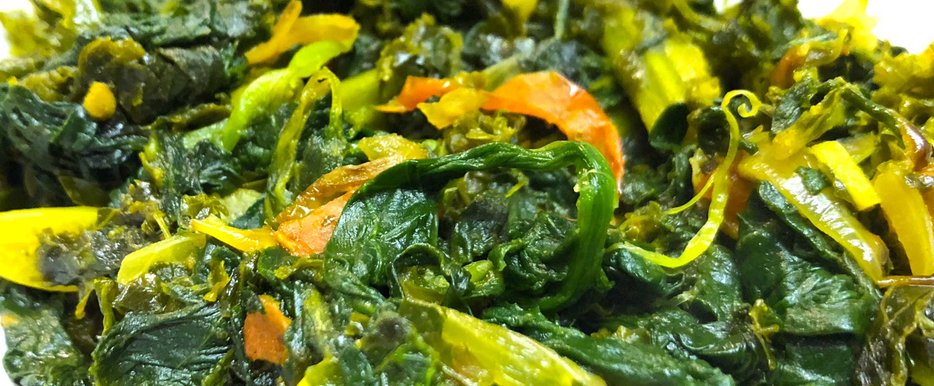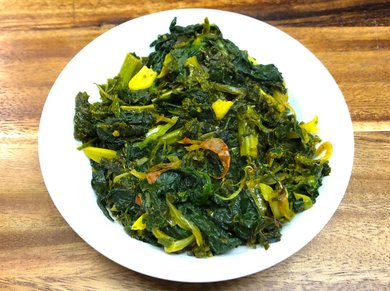Spinach & Kale Sabzi
Spinach (Spinacia oleracea) is an edible flowering plant in the family Amaranthaceae native to central and western Asia. Its leaves are commonly eaten as a vegetable, either fresh, frozen, canned, chipped, or dehydrated.
Raw spinach is 91% water, 4% carbohydrates, 3% protein, and contains negligible fat. Spinach, along with other green, leafy vegetables, contains an appreciable amount of iron attaining 21% of the Daily Value in a 100 g (3.5 oz) amount of raw spinach.
Kale or leaf cabbage are certain cultivars of cabbage (Brassica oleracea) grown for their edible leaves. A kale plant has green or purple leaves and the central leaves do not form a head (as with headed cabbages). Kales are considered to be closer to wild cabbage than most domesticated forms of Brassica oleracea.
Raw kale is composed of 84% water, 9% carbohydrates, 4% protein, and 1% fat.
Spinach and kale sabzi is a healthy and delicious vegetable that goes very well with dal (lentils), steamed rice and yogurt (curd). It is very easy to make and also healthy.
My husband and I, we used to have it normally on weekends, on lunch, we both like it so much. I learned this from my husband, he cooks delicious food and we love to try new recipes.
Kale is slightly bitter in taste, so in this dish we add more spinach than kale. It is a simple yet yummy vegetable.
I used to feel so tired, then I got to know that iron deficiency can make us feel tired. I was deficient in iron, so to keep my iron levels normal and energy high I started eating foods rich in iron, for example spinach or/and kale, as well as food that helps to absorb iron, such as citrus fruits and garlic.
So we invented this high-iron dish of spinach and kale. This helps me in maintaining my iron levels normal and I don't have to take iron tablets.
 Recipe Servings: 2 - 3
Recipe Servings: 2 - 3
 Cooking time: 20 Minutes
Cooking time: 20 Minutes
Ingredients
- Spinach (Palak) - 4 cups
- Kale - 2 Cups
- Onion (finely sliced) - 1 medium
- Tomatoes (chopped) - 2 medium
- Garlic (finely chopped) - 4 cloves
- Ginger (julienne) - 1"
- Green Chillies (finely sliced) - 2
- Turmeric Powder (Haldi) - 1/4 tsp
- Oil - 1.5 tbsp
- Salt - to taste
Preparation
- Chop off the stems of the spinach and kale close to the roots, and throw the roots away. Wash kale and spinach very well under running water until absolutely clean.
- If fresh kale and spinach is not available, you may also use the frozen one.
- Drain them fully and chop them coarsely using a knife. You may also use a salad spinner to chop them. Keep them aside for later use.
- Heat oil in a deep pan on a medium flame. I normally use non-stick pan for cooking vegetables as they don't stick to the bottom of the pan.
- When the oil gets hot, add finely chopped green chillies and ginger juliennes and sauté them till the ginger juliennes turns golden brown. Stir in between so that they won't burn.
- Then add finely chopped garlic and sauté until it starts to turn a pale golden colour. Stir in between.
- Now add finely chopped onions and cook them till they gets translucent. Stir in between.
- Then add chopped tomatoes and let them cook till they gets little mushy. Stir occasionally.
- Once done, add turmeric powder, salt to taste and mix everything well.
- Finally add already chopped spinach and kale and mix well again. Cook them uncovered for about 15 minutes until they gets soft. Stir in between and cook on medium low heat.
- Yummy Spinach and Kale sabzi is ready to serve.
- Serve them with lentils (dal), steamed rice and/or yogurt (curd).
- Enjoy with your loved ones, with your friends and family.



